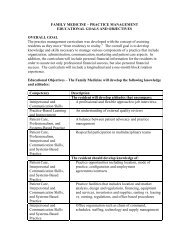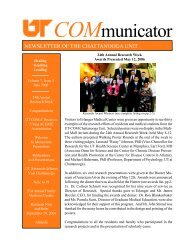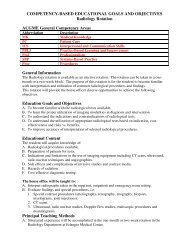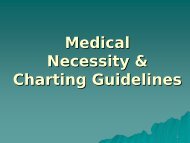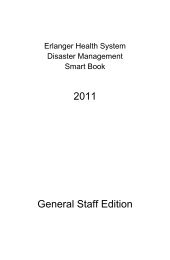Tube Feeding in Patients With Advanced Dementia
Tube Feeding in Patients With Advanced Dementia
Tube Feeding in Patients With Advanced Dementia
Create successful ePaper yourself
Turn your PDF publications into a flip-book with our unique Google optimized e-Paper software.
TUBE FEEDING EFFECTIVENESS IN DEMENTIA<br />
ties of daily liv<strong>in</strong>g, and enteral nutrition<br />
from 1966 through March 1999. In<br />
stroke patients, emaciation may be associated<br />
with slower functional improvement,<br />
48,49 but we found no study<br />
<strong>in</strong> which a nutritional <strong>in</strong>tervention facilitated<br />
recovery of function. Among<br />
100 frail nurs<strong>in</strong>g home residents, oral<br />
prote<strong>in</strong> supplements produced no improvement<br />
<strong>in</strong> measures of strength or<br />
function unless comb<strong>in</strong>ed with resistance<br />
strength tra<strong>in</strong><strong>in</strong>g. 50 A retrospective<br />
review found that no nurs<strong>in</strong>g home<br />
patients had improvement <strong>in</strong> functional<br />
status as measured by the Functional<br />
Independence Measurement scale<br />
dur<strong>in</strong>g 18 months after PEG tube placement.<br />
31 We found no published studies<br />
suggest<strong>in</strong>g that tube feed<strong>in</strong>g can improve<br />
function or mitigate its decl<strong>in</strong>e<br />
<strong>in</strong> dysphagic demented patients.<br />
DOES TUBE FEEDING<br />
IMPROVE PATIENT COMFORT<br />
We searched MEDLINE from 1966<br />
through March 1999 us<strong>in</strong>g the terms palliative<br />
care and enteral nutrition. For many<br />
demented patients, data about symptoms<br />
and symptom control can be based<br />
only on <strong>in</strong>ference. In a prospective observation<br />
of palliative care for term<strong>in</strong>ally<br />
ill patients with anorexia, primarily<br />
with cancer or stroke, few experienced<br />
hunger or thirst. Of those who did, relief<br />
was achieved with small amounts of<br />
food and fluids or by ice chips and lip<br />
lubrication. 51<br />
<strong>Patients</strong> with amyotrophic lateral<br />
sclerosis and dysphagia who had feed<strong>in</strong>g<br />
tubes placed cont<strong>in</strong>ued to cough,<br />
have difficulty manag<strong>in</strong>g oral secretions,<br />
and develop aspiration pneumonia.<br />
Hunger and nausea often began or<br />
<strong>in</strong>creased after tube placement, and human<br />
contact was dim<strong>in</strong>ished. 52 <strong>Tube</strong>fed<br />
patients may be denied the pleasure<br />
of eat<strong>in</strong>g or made uncomfortable<br />
by the tube or frequent reposition<strong>in</strong>g;<br />
some require restra<strong>in</strong>ts. We found no<br />
published studies suggest<strong>in</strong>g that tube<br />
feed<strong>in</strong>g makes dysphagic demented patients<br />
more comfortable.<br />
ADVERSE EFFECTS<br />
We searched MEDLINE from 1966<br />
through March 1999 us<strong>in</strong>g the terms<br />
complication and enteral nutrition and limited<br />
our search to studies of humans age<br />
65 years or older. The many adverse effects<br />
of tube feed<strong>in</strong>g have been divided<br />
<strong>in</strong>to 4 major categories: local or mechanical,<br />
pleuropulmonary, abdom<strong>in</strong>al, and<br />
other (TABLE 2). The most common adverse<br />
effect associated with all types of<br />
tube feed<strong>in</strong>g is aspiration pneumonia<br />
(0%-66.6% 5 ). For PEG tubes, common<br />
adverse effects are tube occlusion (2%-<br />
34.7% 19,31,37 ), leak<strong>in</strong>g (13%-20% 31,32 ), and<br />
local <strong>in</strong>fection (4.3%-16% 19,31,32,60 ). Approximately<br />
two thirds of nasogastric<br />
tubes require replacement. 32,68<br />
CONSERVATIVE<br />
ALTERNATIVES<br />
Discont<strong>in</strong>u<strong>in</strong>g nonessential medications<br />
may reduce eat<strong>in</strong>g difficulties.<br />
Among psychiatric patients, swallow<strong>in</strong>g<br />
dysfunction and chok<strong>in</strong>g have been<br />
associated with certa<strong>in</strong> medications, especially<br />
those with antichol<strong>in</strong>ergic effects.<br />
71,72 Several drugs cause <strong>in</strong>attention<br />
(eg, sedatives), movement disorders<br />
(eg, major tranquilizers), xerostomia (eg,<br />
antichol<strong>in</strong>ergics), esophagitis (eg, alen-<br />
Table 2. Burdens and Complications Associated <strong>With</strong> <strong>Tube</strong> <strong>Feed<strong>in</strong>g</strong><br />
Adverse Effect<br />
Category<br />
Local/mechanical<br />
Pleuropulmonary<br />
Abdom<strong>in</strong>al<br />
Other<br />
Type of <strong>Tube</strong><br />
Nasogastric Gastrostomy and/or Jejunostomy Both<br />
Erosion/necrosis, bleed<strong>in</strong>g of nose,<br />
pharynx, and/or esophagus 52,53,55 ;<br />
postcricoid perichondritis 54 ;<br />
tube misplacement <strong>in</strong>to lung or<br />
bra<strong>in</strong> 43,56 ; high extubation rate;<br />
otitis media; s<strong>in</strong>usitis<br />
Tracheoesophageal or<br />
bronchopleural fistula 55 ;<br />
hemothorax, hydrothorax,<br />
pneumothorax 53,55,57 ;<br />
tracheobronchial perforation;<br />
pneumonitis, lung abscess;<br />
pneumomediast<strong>in</strong>itis; airway<br />
obstruction; <strong>in</strong>fusion <strong>in</strong>to lung<br />
Perforation of esophagus or<br />
duodenum; esophageal stricture;<br />
esophageal bezoar 58 ; reflux<br />
esophagitis<br />
Agitation 53,68 ; requirement for<br />
frequent reposition<strong>in</strong>g; <strong>in</strong>creased<br />
secretions or frequent suction<strong>in</strong>g<br />
Wound dehiscence; bleed<strong>in</strong>g at <strong>in</strong>sertion<br />
site; closure or stenosis of stoma;<br />
sk<strong>in</strong> excoriation; hematoma; erosion<br />
of bumper <strong>in</strong>to abdom<strong>in</strong>al wall<br />
Erosion of tube <strong>in</strong>to pleural cavity<br />
Knott<strong>in</strong>g of tube; tube malfunction 64 ;<br />
tube migration; discomfort from tube;<br />
tube placement failure<br />
Aspiration of feed<strong>in</strong>g<br />
Gastric perforation 60 ; gastric prolapse; Diarrhea; gastro<strong>in</strong>test<strong>in</strong>al bleed<strong>in</strong>g 62,67 ;<br />
gastrocolic fistula 59 ; pneumoperitoneum; bowel obstruction 64 ; nausea 62 ;<br />
pneumatosis <strong>in</strong>test<strong>in</strong>alis 61 ; prolonged<br />
vomit<strong>in</strong>g; promotion of<br />
ileus; evisceration 62 ; acute gastric<br />
gastroesophageal reflux 70<br />
dilatation 65 ; <strong>in</strong>tussusception 66 ; gastric wall<br />
defects 66 ; laceration of esophagus 54 ;<br />
peritonitis 54,60,64,67,68 ; cellulitis 59,62 ;<br />
necrotiz<strong>in</strong>g fasciitis; abdom<strong>in</strong>al or<br />
subphrenic abscess 67<br />
Arrhythmia 26,62 ; laryngospasm; shock;<br />
mediast<strong>in</strong>itis 62<br />
Fluid overload; <strong>in</strong>creased sk<strong>in</strong> moisture;<br />
death; use of restra<strong>in</strong>ts 63,68,69 ; weight<br />
loss 53 ; metabolic disturbance 53 ; loss of<br />
gustatory pleasure; anorexia; loss of<br />
dignity; loss of social aspects of<br />
feed<strong>in</strong>g; altered cosmesis 43,59<br />
1368 JAMA, October 13, 1999—Vol 282, No. 14 ©1999 American Medical Association. All rights reserved.<br />
Downloaded from www.jama.com at MEDICAL LIB on December 15, 2008






